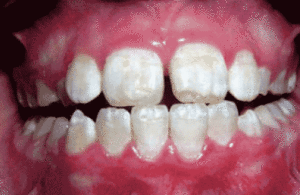An email alert recently brought our attention to some interesting new research on the effects of fluoride.
 Analyzing NHANES data, its author mapped out trends in caries (tooth decay), oral health related quality of life, and fluorosis among kids. Fluorosis is the result of too much fluoride. The teeth become spottily discolored and pitted. In its severe stages, it makes teeth more cavity-prone.
Analyzing NHANES data, its author mapped out trends in caries (tooth decay), oral health related quality of life, and fluorosis among kids. Fluorosis is the result of too much fluoride. The teeth become spottily discolored and pitted. In its severe stages, it makes teeth more cavity-prone.
A couple points jumped out at us, starting with the fact that 57% of kids between the ages of 6 and 19 showed signs of fluorosis. That’s a jump of 20 points over roughly a decade.
For this, we can thank a fluoride-saturated environment. It’s in your toothpaste. It may be in your mouthwash or dental floss. It may be offered to you at your dental cleanings. And, of course, it’s in the water you drink – despite the fact that there is “very little” good, contemporary evidence supporting that intervention and plenty of valid reasons to oppose it.
The other stunning point in this study? During the years fluorosis rates rose, “there was a significant increase in caries experience,” as well.
FAN reports the “data suggests that up to 24 million adolescents now have some form of dental fluorosis, with over 8 million adolescents having moderate fluorosis, and 840,000 having severe fluorosis.”
Yet the study authors suggest that this is a mere aesthetic concern and insist that “he benefit of fluorides outweighs the esthetic impact.”
Other recent research suggests those benefits have been oversold.
A randomized controlled trial published last month in the Journal of Dental Research looked at the relationship between topical fluoride treatment and caries prevention. After all, that’s the main justification for fluoride.
The researchers randomly divided a group of 1248 2- and 3-year olds into two groups. The test group received fluoride treatments every six months over the course of three years. They were also given toothbrushes, fluoridated toothpaste, and standard dental advice. The control group was given just advice. What happened?
Thirty-seven percent of control group participants developed caries.
And so did 34% of those who got the fluoride.
The average number of tooth surfaces affected was 9.6 in the control group and 7.2 in the test group.
In other words,
This well-conducted trial failed to demonstrate that the intervention kept children caries free, but there was evidence that once children get caries, it slowed down its progression.
Well, yippee.
All roads lead back to what we talked about before: If your goal is to prevent tooth decay, the only sensible way to do so is to address the cause, which is too much sugar.
Yes, other factors can make you more caries-prone – smoking, for instance, or eating a highly acidifying diet – but without regular exposure to sugars (which include all fermentable carbohydrates, such as bread, pastas, and potato chips, to name but a few), caries has little chance of taking hold.
To rely on fluoride is to believe the best you can do is limit “inevitable” damage.
But the damage isn’t inevitable. And we can do better. As ever, it starts with diet.
Image by Hardy Limeback, DDS, via FAN